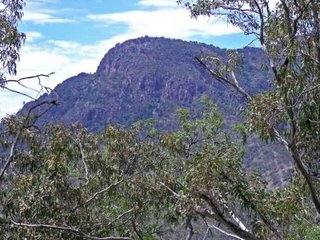We are all imprinted by the immediate environment in which we live and, especially, that within which we grew up. This is as true of people living today as it was for New England's first Aboriginal settlers.
I think that we all know this. But what is perhaps less well recognised is the way in which transport and communications affects our view of the world around us.
Today we live in a world that is both expansive and truncated. Expansive in that communications brings remote parts of the world into our lounge rooms. Truncated in that we know less of our immediate environs. This is partly a matter of individual time, we have access to more information and can only take in so much, but it is also a matter of communications and especially transport time.
Why is this important? Well, as I see it, if you are going to understand the past you have to understand how people thought at the time. This means that you must get out of your own mind frame, back into theirs. And this can be hard because the elements that set our individual mind frames are deeply embedded, unconscious.
To illustrate this, I want to take the New England of 1907. This was the year my grand father arrived in Armidale, starting a love affair with the North that lasted until his death in 1965.
Both population structures and communication systems were very different from those holding today.The country side had then not be depopulated. The rural population, people living on farms and in centres with a population less than 600, varied from area to area but generally made up between 43 and 60 per cent of the total population. A further 16 to 23 per cent lived in towns and villages whose populations ranged between 600 and 2000. (Data drawn from D A Aitkin, The Country Party in New South Wales. A Study of Organisation and Survival. ANU Press, Canberra 1972, p5. Since Aitkin's figures are mainly drawn from the 1921 census, they probably understate 1907 rural populations.)
The end result was a diversified population structure ranged in a distinct hierarchy. At one extreme was the locality or rural district, whose total population could reach several hundred. Such localities were usually, as at Arding near Uralla, centred on the school, church and tennis courts. At the other extreme were the larger towns such as Lismore (7,381 people in 1911) offering a relatively wide range of urban services.
In the middle came a variety of towns and villages. These ranged from small settlements with perhaps just a hotel, bakery and general store, to mining centres based on tin and gold, to timber towns nestling in the hills with their small collections of unpainted weather board houses huddled round the mill, to meduim size towns offering a wider range of services to the surrounding countryside.
No matter how small, these various centres sustained a range of community activities such as church groups, sporting clubs and farmers' organisations. The result was a complex web of relationships, linking the community together.
Transport patterns were also very different. The coast was not then linked together by railway, so that for many journeys it was easier and faster for passengers and freight to travel by coastal steamer. Inland, the train was was the key form of north-south transport (east-west transport was very difficult because of the absence of good roads) channelling passengers and freight first to Morpeth and Newcastle and then, by 1907, to Sydney.
Away from the railways and steamer routes, the horse and bullock were still king, with most towns linked by stage coach with a posting station or inn every sixteen to twenty one kilometres. Growing the feed needed to feed the horses was a major local industry. In addition to the roads themselves, New England was linked by an intricate network of stock-routes, along which mobs of sheep and cattle moved continually.
These different settlement and transport patterns helped mould human thinking. Even with the fastest horse-drawn transport, the distance covered in a day was roughly equal to that covered now by car in one hour on a modern highway; tarvelling as the stock moved, that hour became a journey of more than a week.
To the New Englanders of 1907, their imediate world was huge. meausred as it was in days or even weeks of travel time.It was also more sharply focused: slower transport meant that the knowledge of the landscape was greater; insignificant valleys that today vanish in few minutes then stood out in clear relief. Beyond all this, even though there were large areas with few or no people, it was a populated world. The posting stations and inns, the slower transport that allowed travellers to stop and chat, and the many farming settlements, meant that human life was spread across the landscape.
The heightened awareness of their immediate world helped develop strong emotional attachments between people and the districts they lived in. "South of my day's circle, part of my blood's country," one of Australia's leading poets Judith Wright later wrote of the Tablelands (From "South of My Days", J Wright Collected Poems: 1942-1970, Angus & Robertson, Sydney 1975 p20).
Such strong local links strenthened local loyalties to the point where they hindered (and still do) cooperation with other towns and districts within New England. But over time they also played an important part in the development of a wider Northern loyalty.
The New Englander's perception of the large size of their immediate world was normally associated with a deep seated belief in its development potential. When this was continually frustrated, strong local loyalties were transformed into a sustained attempt to unite New England in order to radically restructure the existing governmental system.














